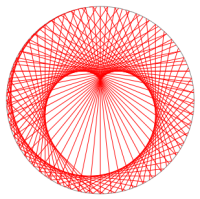Lüroth expansion
This post is my note for What is…? seminar on Lüroth expansion.
Given a system of representation of real numbers in \((0, 1]\), we need to determine whether these representations are 1 to 1 corresponding the numbers in \((0, 1]\). Aslo we should study the (Lüroth) shift map: \[\begin{equation} T: (a_1, a_2, \cdots, a_n, \cdots) \mapsto (a_2, \cdots, a_n, \cdots). \label{20170620-2} \end{equation}\]
Let us define \(T: (0, 1] \to (0, 1]\). For each \(x \in (0, 1]\), define \[\begin{equation} T(x) = \left\lfloor\frac{1}{x}\right\rfloor \left(\left\lfloor\frac{1}{x}\right\rfloor+1\right)x - \left\lfloor\frac{1}{x}\right\rfloor, \label{20170620-3} \end{equation}\]
where \(\left\lfloor\alpha\right\rfloor\) is the largest integer that is no more than \(\alpha\).
Pf. To check this, we need to show that for each \(x \in (0, 1]\), \(T(x) \in (0, 1]\). For such an \(x\), there exists an integer \(n \ge 1\) such that \[\frac{1}{n+1} < x \le \frac{1}{n}.\] Then \(\left\lfloor\frac{1}{x}\right\rfloor = n\). So, \[\begin{equation*} 0 < T(x) = n[(n+1)x-1] = n(n+1)\left(x - \frac{1}{n+1}\right) \le 1. \end{equation*}\] This finishes the proof of the lemma. \(\vartriangleleft\)
Remark. (1) There is more to say from the proof of the lemma: for each integer \(n \ge 1\), \(T\) defines a bijective map between \((\frac{1}{n+1}, \frac{1}{n}]\) and \((0, 1]\).
(2) Suppose \(x \in (0, 1]\) and \((a_1, \cdots, a_n, \cdots)\) is such that Definition 1 holds. Then \(\left\lfloor\frac{1}{x}\right\rfloor = a_1-1\). Hence by definition, we have \[\begin{equation*} T(x) = (a_1-1)a_1 \cdot x-(a_1-1) = (a_2, \cdots, a_n, \cdots) \end{equation*}\] This shows that the definition of \(T\) in \(\eqref{20170620-3}\) make it exactly a shift map in the sense of \(\eqref{20170620-2}\).
Proof. Let’s prove the uniqueness first. Suppose \((a_1, \cdots, a_n, \cdots)\) is a Lüroth expansion for \(x\). Then Definition 1 holds. In the remark above, we see that \[x = \frac{1}{a_1}+\frac{1}{a_1(a_1-1)}T(x).\] Therefore, we have \[\frac{1}{a_1} < x \le \frac{1}{a_1}+\frac{1}{a_1(a_1-1)} = \frac{1}{a_1-1}.\] Since \(a_1\) is an integer, we must have \(a_1 = \left\lfloor\frac{1}{x}\right\rfloor+1\). Recursively, we can determine \(a_2\) using \(T(x)\). In general, we have \[\begin{equation} a_n = \left\lfloor\frac{1}{T^{n-1}(x)}\right\rfloor+1 \ge 2. \label{20170620-4} \end{equation}\]
This proves the uniqueness.
For the existence of such Lüroth expansion for \(x\), we set \(a_n\) by \(\eqref{20170620-4}\). We need to verify Definition 1. But by the definition of \(T\) as in \(\eqref{20170620-3}\), \[x = \frac{1}{\left\lfloor\frac{1}{x}\right\rfloor+1} + \frac{1}{\left(\left\lfloor\frac{1}{x}\right\rfloor+1\right)\left\lfloor\frac{1}{x}\right\rfloor}T(x) = \frac{1}{a_1}+\frac{1}{a_1(a_1-1)}T(x).\] Recursively, we get \[\begin{equation*} x = \frac{1}{a_1} + \frac{1}{a_1(a_1-1)a_2} + \cdots + \frac{1}{a_1(a_1-1)\cdots a_{n-1}(a_{n-1}-1)a_n}T^n(x) \end{equation*}\] Using the facts that \(0 < T^n(x) \le 1\) and \(a_n \ge 2\) for all n, \[\begin{equation*} \lim_{n \to \infty} \left|x - \left(\frac{1}{a_1} + \frac{1}{a_1(a_1-1)a_2} + \cdots + \frac{1}{a_1(a_1-1)\cdots a_{n-1}}\right)\right| = 0. \end{equation*}\] This verifies Definition 1. \(\square\)
Next, we are going into an important property of the Lüroth shift \(T\): \(T\) is ergodic with respect to the usual Haar measure \(\mu\) on \((0, 1]\). Instead of proving it, we are going to explore some interesting properties from this fact together with Birkhoff’s Ergodic Theorem.
Theorem 4 (Birkhoff’s Ergodic Theorem). Let \(f: (0, 1] \to \R\) be a measurable function. Then for almost every \(x \in (0, 1]\), \[\begin{equation} \lim_{n \to \infty} \frac{1}{n}\sum_{i=0}^{n-1} f \circ T^i(x) = \int f \, d\mu. \label{20170620-5} \end{equation}\]
Example 1. Let \(A\) be some measurable set in \((0, 1]\), and define \[\begin{equation*} f(x) = \left\{\begin{array}{ll} 1, & x \in A \\ 0, & x \not\in A \end{array}\right.. \end{equation*}\] Then Theorem 4 is amount to say that “time-averages” is the same as “space-averages” almost everywhere for the Lüroth shift \(T\). Indeed, this is a general property for all ergodic maps.
Example 2. Let \(k\) be an integer such that \(k \ge 2\). Define \[\begin{equation*} f(x) = \left\{\begin{array}{ll} 1, & a_1(x) = k \\ 0, & \text{otherwise} \end{array}\right., \end{equation*}\] where \(a_1(x)\) is the first term of the Lüroth expansion of \(x\). The left hand side of \(\eqref{20170620-5}\) calculate the average appearance of \(k\), and the right hand side is equal to \(\frac{1}{k(k-1)}\) since \(f(x)=1\) if and only if \(x \in (\frac{1}{k-1}, \frac{1}{k}]\). Therefore, the average appearance of \(k\) is \(\frac{1}{k(k-1)}\), for \(k \ge 2\).
Example 3. Define \[f(x) = \ln\left(\left\lfloor\frac{1}{x}\right\rfloor+1\right).\] Suppose \(x = (a_1, \cdots, a_n, \cdots)\) is a nice point in \((0, 1]\). By \(\eqref{20170620-4}\), the left hand side of \(\eqref{20170620-5}\) becomes \[\lim_{n \to \infty} \frac{1}{n}\sum_{i=1}^{n} \ln a_i.\] For the right hand side, \[\begin{equation*} \begin{split} \int_0^1 f(x) \, dx &= \sum_{n=1}^{\infty} \int_{\frac{1}{n+1}}^{\frac{1}{n}} \ln(n+1) \, dx \\ &= \sum_{n=1}^\infty \frac{\ln(n+1)}{n(n+1)} \approx 1.22638 \end{split} \end{equation*}\] Therefore, \[\lim_{n \to \infty} \sqrt[n]{\prod_{i=1}^n a_i} \approx e^{1.22638}.\]
